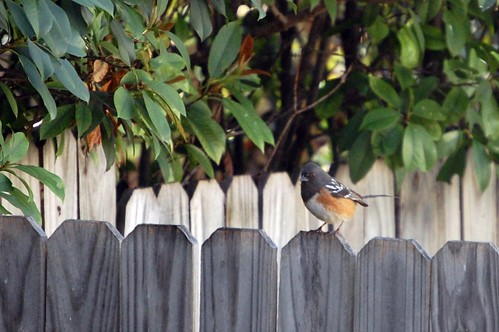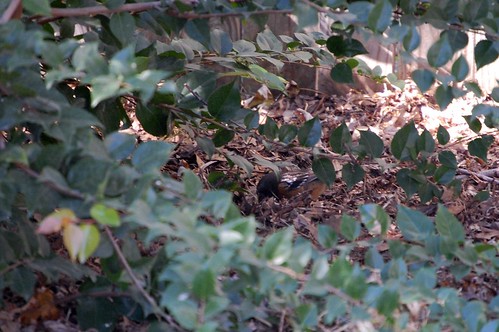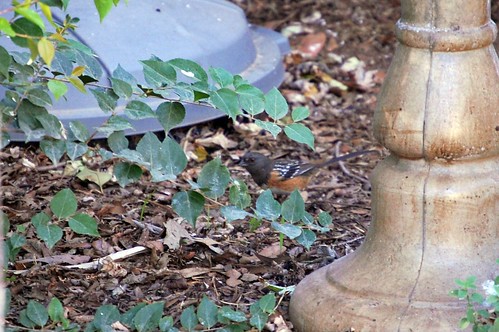
In November and again on Monday, we noticed a new bird in our yard, the spotted towhee. According to the bird book, the spotted towhee is a winter resident with a black head and back, white wing markings, rust or rufous colored sides and a red eye.


It was sound, not sight, that first clued us in to this visitor. My husband had the windows open, and he heard continuous rustling in the mulch. It wasn't the gentle examining that a wrens and cardinals do, but powerful and purposeful rummaging, like a chicken scratching for bugs.


Towhees like to hunt in shrubby undergrowth. Our growing xylosma hedge seems to fit that description, and we've enhanced the habitat by filling the beds with shredded sycamore leaves from a neighbor's tree.
Speaking of birds, if you live in South or Central Texas, I have a recommendation for you. Check out this birding blog that my friend Sam recently launched. Whenever I am stumped by a bird ID question, Sam has the answer. (He identified this generic looking warble for me last year.) He also tips me off to when seasonal are birds have made their appearance. I'm always impressed by his adventures and bird knowledge.
Wow, what a cute bird. Thanks for the tip on the birding website. There are some I can't identify and this will be a big help.
ReplyDeleteThanks for following the blog. I'll be glad to help with IDs. If I can't figure it out, I've got several friends who can help.
DeleteNeat. I'll be on the lookout since we live in the same area. Thank you for the link to the birding blog. I checked it out and it is very informative. Looking forward to following along.
ReplyDeleteGlad you like the blog. It will be good to have you along for the ride.
DeleteThanks, Abbey! I have some fond memories of looking for Spotted Towhees at my parent's ranch when I was a kid. They always hung out near a red gate in the middle of the property. We frequently kept a look out for them while driving by.
ReplyDeleteAt the time, they were called Rufous-sided Towhees and there were eastern and western subspecies. However, today, these two subspecies are now considered individual species - Spotted Towhee and Eastern Towhee. This is good for birders because we get to count more birds on our list!
How fun to see a new bird! We have Eastern towhees that mainly hang out in the woods nearby, but every so often we see them in our yard. At least they are very distinctive! I have so much trouble figuring out some types of birds (pretty much a lot of the brown ones!)
ReplyDeleteTowhees are so fun! They're just different enough from other birds that it is a real treat to see them, especially in your backyard! Yay!
ReplyDeleteSuch a cutie and good a disguise too. Indeed, you really had a fin time in your backyard. Great post!
ReplyDeleteWhat a cutie! I'm really just starting to get into the birds in and around my garden...I still get really excited any time I actually know one of their names!
ReplyDeleteAbbey- I think it was you who asked for some demettiana? I have a couple of pups. Send me an email at jennyrockrose@gmail.com with your address. If not just ignore me.
ReplyDeleteDo you think that you have so many more interesting birds in your yard because of all your beautiful plants? Do the plants attract them? We just have the regular guys that I've seen - mockingbirds, blue jays and grackles.
ReplyDeleteAfter watching the yard for a few years, I think that the biggest factor affecting the number of bird species are the trees and shrub that provide cover the make the birds feel safe.
DeleteFor instance, I've noticed that when I hang a feeder on the left side of the arbor, over veggie garden where there is little cover, it doesn't attract as many birds as the same feeder does when I switch it to the right side of the arbor where a predator bird cannot fly in a straight line toward it. The predator would have to maneuver between a crepe myrtle, another tree, the arbor and a massive climbing rose to access the feeder. http://flic.kr/p/8RXiVk
The same factors seem to be at work with the shrubs near the back fence. As the shrubs have grown, the birds feel safe hopping between, below and near them. They don't seem interested the type of plants, per se, just that they suit their needs.
On the other end of the spectrum, my brother in law lives on a lot where he has a fair number of established oak trees and his neighbors do too. He doesn't even have to hang feeders, and he gets a dozen more bird species than I do. At my house, we only have one tree in the backyard, and our our neighborhood doesn't have the same network of tree cover that his does.
If you're neighborhood isn't blessed with lots of trees, you can make your yard a bird oasis by layering shrubs and clear spaces so that they shrubs are not all on the same plane. My other trick is keeping the bird bath full. All types of birds LOVE the bird bath. I think water is the second most important factor, but it is neck and neck with cover. The last trick comes in a distant third, and that's serving a mix of quality food. For my own amusement, I get seed and nuts from Lockhill Feed on Huebner. They have 5 gallon buckets with all types of seeds, and you scoop what you want into a paper sack. They also sell mealworms for birds that don't eat seeds. Their prices are CHEAP and since you control the quantity you buy, you can leave the store for only $5 and have enough seed to get a kick out of watching the birds for a whole weekend. (Normally, I only fill the feeders on the weekends when I am around to watch.)
That's probably a much longer answer than you needed, but I'm glad you asked. I was disappointed with my birds for a while and always thought other people had some sort of magic, but now that I understand the factors at play, it's fun to influence them and watch for new visitors.